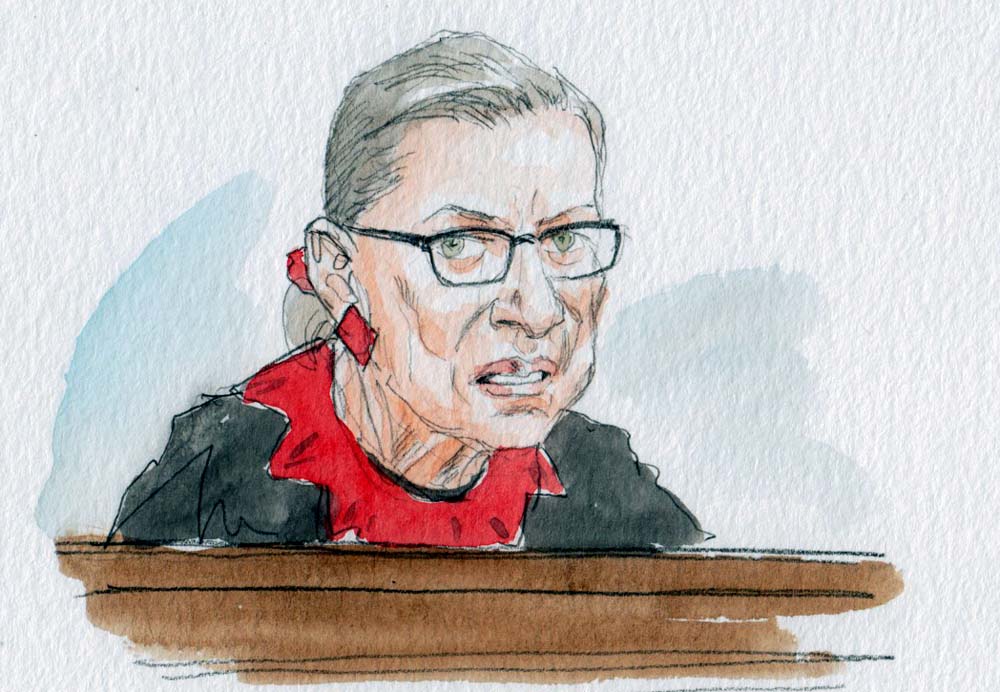A portrait of an extraordinary life

This tribute is part of a series on the life and work of the late Justice Ruth Bader Ginsburg.
Ruthanne Deutsch is a founding partner at Deutsch Hunt PLLC. She clerked for Ginsburg during the 2007-08 term.
I remember my clerkship interview with Justice Ginsburg as if it were yesterday. I arrived with instructions from helpful former clerks to count to “3 Mississippi” after her pauses, to be sure she had finished saying what she wanted. A high school friend encouraged me to think of her as my Bubba from Brooklyn. The justice was formal (and formidable). But she also was warm, engaged and appreciative of my having attended law school as the mother of two young children. “Two is something,” she gracefully noted. “I only had to care for one child during law school.” Of course she neglected to add that when she was in law school, she also cared for a husband undergoing cancer treatments — essentially taking his classes as well as her own — all while performing at the very top of her class.
As the interview came to its close, we spent some time walking through her chambers looking at the many photographs lining her bookshelves. She paused before her favorite, a picture of her son-in-law with two of her grandchildren, taken when they were small. “This,” she said, “is hope for the future.” What she meant was a world where we all can realize our full potential as human beings, not relegated to the confines of socially (or legally) imposed gender roles. Men can be caregivers just as women can be breadwinners. And the law should pose no obstacle to the full range of life choices and opportunities for anyone, regardless of their gender (or race, or sexual orientation). No surprise that one of her favorite cases from her storied career fighting for gender equality was Weinberger v. Wiesenfeld (1975). There, the Supreme Court struck down as unconstitutional a gender-based distinction under the Social Security Act that permitted widows but not widowers to collect special benefits while caring for minor children.
Fast forward to the first day of my clerkship, which happened to coincide with my older son’s 10th birthday and was also Justice Thurgood Marshall’s birthday. RBG could not have been more welcoming to the boys and their dad and grandma when they arrived at day’s end. She wished my son happy birthday and talked a bit about Justice Marshall (whose chambers she was then occupying) while showing them around. Later that term, she was very excited to have kids to invite to the marvelous children’s opera Hansel and Gretel, treating my co-clerks and me to a bonus second opera outing. And while my clerkship year was laser-focused on the work of the court — RBG held me to the highest standards as a legal writer — she always had my back as a mom, trusting me to get it all done in the way that worked best for me and my family. And I like to think that she helped me become a better parent, by modeling what it was to expect excellence in the most gracious and kind way.
How is one to capture the vitality of a brilliant, one-of-a-kind national icon? Two years ago, I had the honor of serving on the justice’s portrait committee. I watched as the artist C.P. Beaty tried to answer that question in paint. Justice Ginsburg’s portrait, which will soon be hanging on the walls of the Supreme Court, captures the idea – perfect for RBG — that “your library is your portrait.”
If you ever get a chance to see it in person, after appreciating the magnificent figure of the justice, look closely at what else is there. You will see her daughter Jane’s copyright texts, the Chef Supreme cookbook with husband Marty’s poetic recipes, and CDs from son James’ record label. All creations of the justice’s family, all part of the portrait, all part of a generative, extraordinary life.
And take time, too, to peer at the subtle and beautiful sgraffiato, or etchings, along the painting’s frame. Elements, drawn from architectural features of the court, include the scales of justice, images of the goddesses Juno and Minerva (figures of wisdom and wise counsel) and peacocks, symbolizing immortality. The edelweiss flower shows up, as well — a wink to the artist’s grandfather Richard Rodgers, but also a symbol of courage, and, believe it or not, notoriety.
Finally, in the frame’s bottom center, there is a musical scale with the first note of “Marschallin’s Aria re Time,” the justice’s favorite aria. From the first act of the Richard Strauss opera Rosenkavalier, the aria begins with the chiming of a clock. Time is short, so much to do, it seems to say. And although the justice is no longer with us, her legacy endures, through the cases she fought, the opinions she wrote, and the continued efforts of all those she taught and mentored, bending the arc toward justice through our sustained commitment to the law.
Posted in Tributes to Justice Ruth Bader Ginsburg
